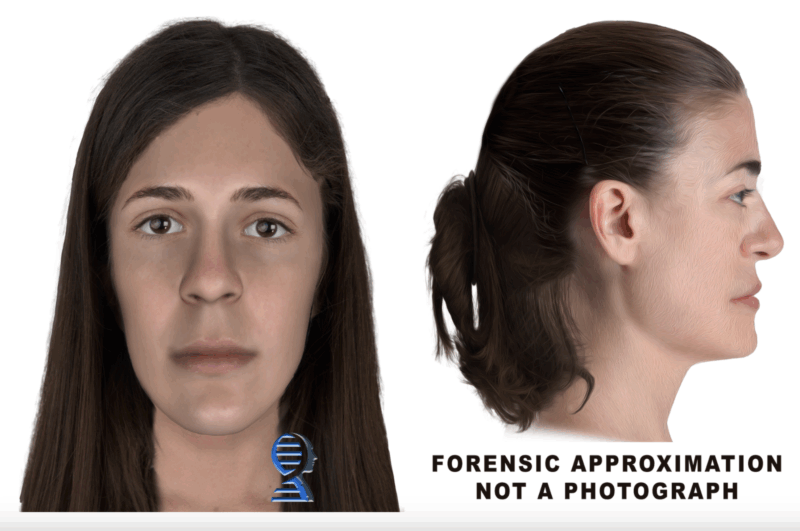Oregon State Police announced Tuesday, Sept. 16, that they have identified the skeletal remains of a young woman discovered in 49 years ago east of Sweet Home.
On July 24, 1976, the skeletal remains of the young woman were found in the area of Wolf Creek near Swamp Mountain.
In June the remains were positively identified as Marion Vinetta Nagle McWhorter, OSP announced in a statement on Sept. 16. McWhorter had last been seen at a Tigard shopping mall in 1974. She was 21 years old at the time and was never heard from again.
In 1976, a moss hunter discovered a skull with several teeth and notified local law enforcement immediately. The Linn County Sheriff’s Office accompanied the moss hunter back to the site and recovered additional skeletal remains. Along with the remains, investigators located a clog-style shoe, a fraying fringed leather coat, a leather belt with Native American-style beadwork, two metal rings, and a pair of degraded Levi’s jeans, which were retained as evidence.
The skeletal remains were transferred to the Oregon State Medical Examiner’s Office, where they were examined by a pathologist and odontologist. The findings of the examination were undetermined due to the limited number of elements recovered. The dental examination noted several restorations.
In 2010, the Oregon Museum of Natural and Cultural History completed an anthropology report. A biological profile provided a probable estimation of a white female under 35 years of age at the time of her death. However, she remained unidentified.
Later that year, a bone sample was submitted to the University of North Texas Center for Human Identification, and a NamUs profile was created.
From 2011 through 2025, the case received consistent attention from the State Medical Examiner’s Office. DNA results were uploaded to the Combined DNA Index System (CODIS); however, no genetic associations were discovered.
The NamUs system was regularly checked for new cases that might match the decedent. While the DNA results confirmed the remains were female, no ancestry or phenotype could be determined due to the limitations of the STR DNA (short segments of DNA) profile.
In 2011, a forensic artist with the Clackamas County Sheriff’s Office assisted in creating a potential forensic rendering of the decedent’s face based on cranial features. A clay model featuring several different hairstyles and colors was created to help establish a recognizable image.
By 2020, the Oregon State Medical Examiner’s Office had been awarded a National Institute of Justice grant to perform advanced DNA techniques on unsolved unidentified skeletal remains cases. This case was recognized as one that could potentially be resolved through DNA phenotyping and investigative genetic genealogy, provided by OSP’s vendor lab, Parabon NanoLabs. An additional bone sample was submitted for DNA extraction, and in November 2020, a SNP DNA (a unique genetic marker) profile was successfully produced and analyzed.
A Parabon NanoLabs DNA Snapshot Report, which utilizes genetic material to determine eye color, hair color, skin tone, and ancestry, was completed. The report predicted the individual was of European and Indigenous North American descent, with unfreckled fair skin, brown eyes, and brown hair. A rendering of her facial characteristics was created and used as her NamUs profile picture. A subsequent genetic genealogy report was completed in 2023, but did not produce any promising leads.
A breakthrough in the case occurred in April 2025, when someone spontaneously uploaded their genetic profile to the Family Tree DNA database, providing genealogists with a much closer look into the unidentified woman’s family tree. Forensic scientists followed genetic and other leads and ultimately determined that McWhorter was likely the unidentified young woman.
Genealogists found that McWhorter had one surviving family member, a younger sister living in the Seattle area. A Linn County Sheriff’s Office detective contacted the sister, who provided an oral swab for DNA comparison and shared the story of her long-lost older sister.
Genetic evidence confirmed that the decedent was Marion Vinetta Nagle McWhorter, born on Jan. 7, 1953, and who had been unaccounted for since 1974. Based on the totality of the evidence, Oregon Chief Medical Examiner Dr. Sean Hurst positively identified the remains and confirmed the findings with McWhorter’s remaining family.
The Linn County Sheriff’s Office is aware of the case and is working to determine, if possible, the circumstances of Marion McWhorter’s death.
“Discovering Marion McWhorter’s identity was a remarkable collaboration among detectives, medical examiner staff, and forensic genetic genealogists at Parabon NanoLabs,” the OSP said.
“This case was cold for 49 years,” said State Forensic Anthropologist Hailey Collord-Stalder. “That means that family members lived and died without ever knowing what happened to their missing loved one.
“Forensic genetic genealogy allowed us not only to assist Oregon law enforcement and medicolegal personnel in identifying a woman who likely did not go missing voluntarily, but it also helped provide her family with answers and help relieve the uncertainty of what happened to Marion McWhorter.”





